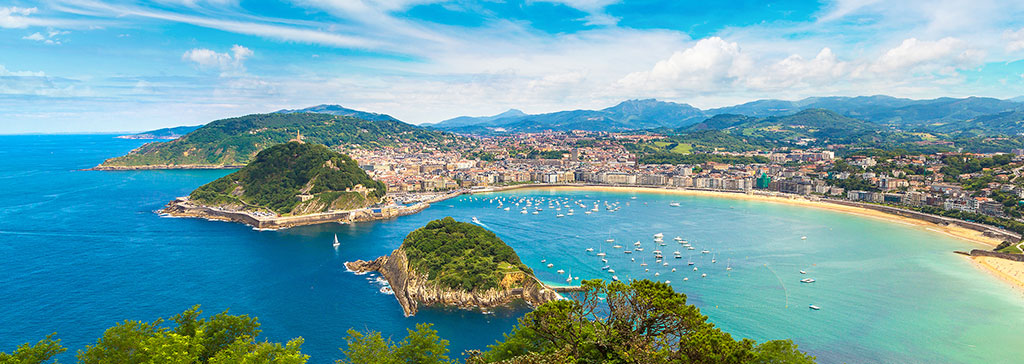

10 Best Small Cities in Europe
The major European cities have their obvious draws, but what about small cities in Europe? This side of Europe gives the traveller a more intimate look at local life and culture without the big-city stress. Chill out in the sunshine at a riverside park, grab a glass of wine at a sidewalk café or walk through centuries-old cobbled streets. This is what Europe is all about.
The European train network is even more extensive than you might have thought. Not only does a high-speed rail network connect the big cities, but a vast grid of regional lines gets you out to the provinces. With a Global Pass, you are good to hope and ride out any one of the following 10 extraordinary small cities in Europe.
1. Olomouc, Czech Republic

Czechs refer to Olomouc as “better Prague” and travellers in the know agree. It’s a gorgeous, historic city that will impress you with its authenticity and virtual lack of tourists. Its restaurants and micro-breweries are great places to sample local food and freshly brewed beer that has made this country famous. Granted, Prague is beautiful, but take a breather and enjoy the stress-free atmosphere of Olomouc.
How to get to Olomouc by train: The journey from Prague’s main railway Station to Olomouc is slightly over two hours on the SuperCity train. Reservations for the SuperCity are compulsory for Global Pass holders. Regional and Express trains take slightly longer and do not require a reservation.
2. La Rochelle, France

This once great French coastal city is, well, still great. But instead of serving as a home to fishing fleets and trading vessels to the new world, La Rochelle now houses one of Europe’s biggest fleets of pleasure boats. Before leaving the luminous limestone facades of the well-preserved Vieux Port, cycle around the nearby Île de Ré. This island shelters relaxed villages and long sandy beaches.
How to get to La Rochelle by train: The high-speed TGV from Paris Montparnasse station departs about every 2-3 hours, cruising to La Rochelle in about 3 hours. Reservations are compulsory.
3. Bern, Switzerland

Bern was the home of Albert Einstein, has bears living in its downtown, and is the capital of Switzerland. All nifty facts — but not even the best reason to visit Bern. What makes Bern so wonderful is its sleepy arrangement on the hilly ground above a graceful bend in the River Aare. Its assembly of twelve 16th century fountains and its medieval covered shopping arcades contribute to making the historic centre of Bern a World Heritage site.
How to get to Bern by train: Bern makes a nice day outing from Geneva or Zurich. There are several daily trains taking less than two hours. The IR, ICN, RE, and IC trains conveniently do not require a reservation or fee. Bern’s train station is located right in the old city and left luggage is available.
4. Santiago de Compostela, Spain

Famous as a pilgrimage destination, Santiago de Compostela lies in the remote northwest corner of Spain. Don’t worry, the rail network also reaches here. Catholic devotees come to pay homage to the bones of St. James. You can admire their commitment after walking across the entire country on the Camino de Santiago. The city also gives you a peek into life in Galicia — a region of Spain with its own language, culture, and customs. Don’t forget to try some classic regional cuisine: pulpo (octopus), pimientos de padrón (fried peppers) and the local cloudy white wine.
How to get to Santiago de Compostela by train: Nearly all trains in Spain require reservations and their associated fees. The Alvia train ploughs the route from Madrid in less than six hours.
5. Turku, Finland

Turku is the ancient capital and easy-going hip city on Finland’s southwest coast. Dating from the end of the 13th century, Turku is the oldest city in the country. It is also home to the well-preserved Turku Castle. Open to visitors, it is the largest surviving medieval building in Finland and serves as a national monument.
How to get to Turku by train: A day trip from Helsinki offers you a glance at the endless evergreen forests and placid lakes of the Finnish countryside along the way. The rail system in Finland is renowned: it is modern, efficient, and the trains are spotless. Turku is only 2 hours away by InterCity train from Helsinki’s central station (Rautatieasema). No reservation is required.
6. Porto, Portugal

Porto is often overshadowed by its rival to the south, the bigger city, and capital of Portugal, Lisbon. They are both worthy of a visit, but I like Porto because of its authentic grittiness and work-hard, play-hard mentality. But it’s not just a city to look at. Go visit one of the Port wine cellars or take a ride on the scenic rail line up to Pocinho and the Douro Wine region.
How to get to Porto by rail: Trains cover the route from Lisbon’s Santa Apolonia or Oriente station at least once per hour and take about 3 hours in total. IC and AP trains have a compulsory small fee. Best to stay a night or two in Porto to really get a feel for the city.
7. Varna, Bulgaria

Where has Varna been all your life? A historic, slow-paced city on a stunning strip of Black Sea coast, Varna is known as Bulgaria’s summer capital. In Varna, you’ll literally bump into ancient Roman foundations while walking down the street. The world’s oldest find of gold artefacts was discovered in Varna — dating from 4,750 BC!
How to get to Varna by rail: Trains leave Sofia throughout the day and take about 7-9 hours. Also, look out for the night train, which pulls into Varna in the early morning.
8. Orvieto, Italy

A wander through the winding cobbled streets of a medieval hill town is reason enough to visit Umbria. This is one of the most charming small cities in Europe. The train ride through the rural landscape of vineyards and farms is a bonus. There are few other cities with such a dramatic setting. Perched high above the valley floor, on a flat summit of a large butte of volcanic rock, Orvieto is reached by funicular from the train station.
The city is known for its exceptional cathedral, which along with a tour of the underground city, is manageable on a day trip from Rome. Finish your day with a glass of celebrated Orvieto white wine on the outdoor terrace of one of the town’s many bars. Alternatively, make Orvieto a stop-off between Rome and Florence. Note there is no bag storage at Orvieto station.
How to get to Orvieto by train: Only Intercity and regional trains service the city, both of which do not require reservations.
9. Lugano, Switzerland

You will remember not only San Sebastian’s picture-perfect stretch of crescent beach and elegant old city long after you leave, but the delicious food you’ve eaten there. Situated in Spain’s Basque country, Donostiarra, as residents of the city are known, munch on pintxos (rather than tapas) as they nurse their small beers and glasses of wine.
How to get to Lugano by train: You can make the journey in about 5.5 hours from Madrid with a reservation.
10. San Sebastian, Spain

You will remember not only San Sebastian’s picture-perfect stretch of crescent beach and elegant old city long after you leave, but the delicious food you’ve eaten there. Situated in Spain’s Basque country, Donostiarra, as residents of the city are known, munch on pintxos (rather than tapas) as they nurse their small beers and glasses of wine.
How to get to San Sebastian by train: You can make the journey in about 5.5 hours from Madrid with a reservation.
You might like this as well:
-
![empty-parliament-hall]() 7 Beautiful Parliamentary Buildings In Europe Explore Europe by train with Interrail, and don't miss these impressive parliamentary buildings on your travels.
7 Beautiful Parliamentary Buildings In Europe Explore Europe by train with Interrail, and don't miss these impressive parliamentary buildings on your travels. -
![spain-san-sebastian-bay-panorama]() 10 Best Small Cities in Europe Want to explore the less crowded side of Europe? Get ready to explore 10 captivating small cities by rail with a Global Pass.
10 Best Small Cities in Europe Want to explore the less crowded side of Europe? Get ready to explore 10 captivating small cities by rail with a Global Pass.
Change of currency
You cannot change the currency once you have a Pass in your cart. Remove the Pass, and then change the currency on the website header.







